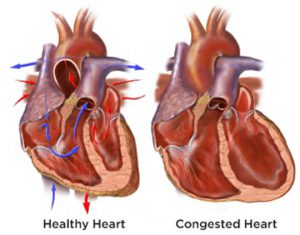Congestive Heart Failure
Congestive heart failure occurs when your heart muscle doesn’t pump blood as well as it should. This condition can cause  congestion in the circulatory system, particularly in the lungs, liver, and lower portion of the legs, where the blood pools. Swelling in the ankles is one of the first complaints of people with congestive heart failure. Medical notes by the treating physician are very important sense this swelling in the ankles or signs of lung congestion will be recorded by the doctor. If the doctor has recorded these signs and symptoms, then the Social Security Administration will be more likely to believe the doctors opinion concerning functional limitations.
congestion in the circulatory system, particularly in the lungs, liver, and lower portion of the legs, where the blood pools. Swelling in the ankles is one of the first complaints of people with congestive heart failure. Medical notes by the treating physician are very important sense this swelling in the ankles or signs of lung congestion will be recorded by the doctor. If the doctor has recorded these signs and symptoms, then the Social Security Administration will be more likely to believe the doctors opinion concerning functional limitations.
The New York heart Association has created guidelines that place the patient in different categories depending on the seriousness of the congestive heart failure:
| Class I | No limitation of activities; you suffer no symptoms from ordinary activities |
| Class II | You have a slight, mild limitation of activity; you are comfortable with rest or with mild exertion |
| Class III | You have a marked limitation of activity; you are comfortable only at rest |
| Class IV | You should have complete rest, you are confined to a bed or to a chair; any physical activity causes discomfort and symptoms occur at rest |
If you have congestive heart failure, you should talk to your doctor and find out which category you fall into under the New York Heart Association classification of limitations. The last two categories are clearly disabling, however, your medical evidence still needs to be credible when presented to the Social Security Administration (i.e., documented functional limitations by your doctor). The first two categories are not normally taken seriously by the Social Security Administration unless the heart condition is presented in combination with other impairments. During a social security disability hearing, swollen ankles may be shown to the judge. The need to elevate your legs because of blood pooling in your lower legs or ankles is extremely important and the judge needs to know. The total picture of your medical condition and functional limitations need to be presented to the judge.
What Our Clients Say:
Member:

Attorney Gregory Kornegay
Greg is a trial attorney in Wilmington with over 30 years of experience. Greg was born and raised in southeastern North Carolina. Before law school he managed a store with employees making a payroll every week. His first job out of law school was as an Assistant District Attorney investigating and trying cases for the State of North Carolina. Through the years he has handled many different types of cases – including death penalty cases.
Being married with children has been a blessing and a challenge, but has served him well in understanding the problems individuals and families face as they live out their lives. Greg believes that each case is different and the needs of each client are unique, but there are certain themes of life that we all share.


